City of Terni
City of Terni: The Town Between Waters
The Michelangelo Palace Hotel recommends what are the 10 things to do in Terni
City of Terni: Historical Background
Popolate in the Iron Age (acciaierie and San Pietro in Campo necropolises), it was the town of the Umbrians and later a thriving Roman town with the name of Interamna Nahars, that is “town between the rivers”. After the fall of the Roman Empire, it was invaded by the Goths and the Longobards; it was a battlefield for Guelfs and Ghibellines, and between the Papacy and the Empire. It was ruled by many lordships until it became part of the Papal States. In the mid 19th century, the wealth of watwerways and its central location in Italy brought about the industrial boom in the steel, engineering, chemical and hydroelectric sectors.
City of Terni: The Layout
Terni features the original mediaeval centre built on the former Roman town and partly encircled by the old walls. The housing expansion boosted by industrialisation resulted in a modern and dynamic town: in fact, following the wartime bombing it rose again from its ruins thanks to the reconstruction works planned by the architect Ridolfi.
City of Terni: A tour of the town
1 – The Marmore Waterfall embodyng the beauty and the force of nature
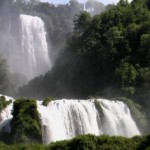 The Marmore Waterfall is one of the most attractive sceneries. It is 531 ft in height and plunges with a three-jump drop into the Nera river. Its beauty has always been celebrated by painters, poets and famous figures, such as Virgil, Galilei, Corot, lord Byron, by writers such as Alfieri and Andersen, and by many European sovereigns. It used to be one of the principal and most charming destinations of the Grand Tour.
The Marmore Waterfall is one of the most attractive sceneries. It is 531 ft in height and plunges with a three-jump drop into the Nera river. Its beauty has always been celebrated by painters, poets and famous figures, such as Virgil, Galilei, Corot, lord Byron, by writers such as Alfieri and Andersen, and by many European sovereigns. It used to be one of the principal and most charming destinations of the Grand Tour.
It was conceived by Consul M.Curio Dentato in 271 BC in an attempt to drain the swampy Rieti plain by diverting the Velino into the Nera ( Cava Curiana ). Its course was laterimproved, above all in the 18th century by order of Pope Pius VI with the diagonal cut. The area around the Waterfall features a Visitors’ centre providing guided tours on the paths leading up to the Rock.
2 – The Cathedral
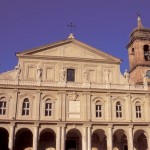 Although it has preserved its 17th-century structure, the Cathedral dates back to earlier times, as witnessed by the crypt and the remains of sacred early Christian buildings. The columns of the portico and the portals are in Romanesque style. Inside, tourists will be delighted by a fine organ and a baldacchino, both from a design by Bernini, the worshipped painting of the “ Madonna of Mercy “ by Carlo Maratta, as well as the works of art by Agresti and Barberis.
Although it has preserved its 17th-century structure, the Cathedral dates back to earlier times, as witnessed by the crypt and the remains of sacred early Christian buildings. The columns of the portico and the portals are in Romanesque style. Inside, tourists will be delighted by a fine organ and a baldacchino, both from a design by Bernini, the worshipped painting of the “ Madonna of Mercy “ by Carlo Maratta, as well as the works of art by Agresti and Barberis.
3 – Basilica di San Valentino
 It was built on the site that the disciples of St. Valentine had chosen as the resting place of the Bishop of Terni, martyred in the year 273. It was rebuilt many times and the present structure was begun in 1606 to be then embellished in later years. It consists of a nave with chapels decorated with such paintings as the “ Madonna and Child with Saints “ by A. Polinori ( 1635 ), “ Madonna with Child “ by Lucas de la Haye, who is also the author of 4 painting portraying “ StValentine’disciples “, and “ StMichael Archangel defeats the Devil “ by Cavalier d’Arpino ( 17th c. ).
It was built on the site that the disciples of St. Valentine had chosen as the resting place of the Bishop of Terni, martyred in the year 273. It was rebuilt many times and the present structure was begun in 1606 to be then embellished in later years. It consists of a nave with chapels decorated with such paintings as the “ Madonna and Child with Saints “ by A. Polinori ( 1635 ), “ Madonna with Child “ by Lucas de la Haye, who is also the author of 4 painting portraying “ StValentine’disciples “, and “ StMichael Archangel defeats the Devil “ by Cavalier d’Arpino ( 17th c. ).
The Crypt and the urn with the relics of St Valentine are also worth seeing.
4 – Fausto Amphitheatre
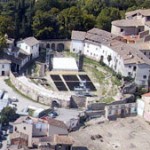 It dates back to the 2nd century AD and represent the sole survivor of the Roman Interamna. It consists of a gallery, an ambulatory and an arena used for shows and concerts.
It dates back to the 2nd century AD and represent the sole survivor of the Roman Interamna. It consists of a gallery, an ambulatory and an arena used for shows and concerts.
Nearby are the remains of the Theatre and a bath with mosaic floor ( Palazzo Gazzoli ), other remains of public buildings ( San Salvatore Church ) and of a basilica ( piazza San Giovanni Decollato ). Remnants of the Roman town are parts of the walls made of large blocks, trasformed in the Middle Ages. Visit by appointment only during the opening hours of the Museum CHAOS – From Tuesday to Sunday: 10-13 / 16-19 – Closed on Mondays Admission: Adults: € 5.00 Reduced: € 3.50. Integrated Ticket (Museums + Carsulae): € 7,00 * The ticket is also valid for visiting the Museum of Modern and Contemporary Art “Aurelio De Felice”, the Archaeological Museum and Paleolab.
5 – San Francesco Church and Paradisi Chapel
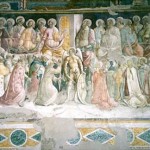 Its construction in Gothic style began around 1265 and it was altered in the 15th century. Remarkable is the Paradisi Chapel. The frescoes – one of the most interesting 15th century cycles of Umbrian art – were carried out by Bartolomeo di Tommaso ( 15th c. ). They depict the “ Last Judgment “ with the dramatic representation of Hell ( right wall ) Purgatory ( left ), the “ Christ descending into Limbo “ and “ Paradise “ ( bottom wall ) with Jesus, St John the Baptist, the Madonna, St Peter, the Angels, the Apostles, and the Saints. The vault shows pictures of the Prophets.
Its construction in Gothic style began around 1265 and it was altered in the 15th century. Remarkable is the Paradisi Chapel. The frescoes – one of the most interesting 15th century cycles of Umbrian art – were carried out by Bartolomeo di Tommaso ( 15th c. ). They depict the “ Last Judgment “ with the dramatic representation of Hell ( right wall ) Purgatory ( left ), the “ Christ descending into Limbo “ and “ Paradise “ ( bottom wall ) with Jesus, St John the Baptist, the Madonna, St Peter, the Angels, the Apostles, and the Saints. The vault shows pictures of the Prophets.
6 – Sant’Alo’ Church
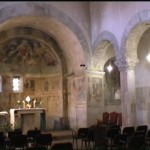 The main entrance of this 11th century building is on the side and is decorated by Roman ( the two lions on both sides of the steps ) and early-mediaeval elements. The inner walls are covered with frescoes, probably dating from the 13th to the 17th centuries.
The main entrance of this 11th century building is on the side and is decorated by Roman ( the two lions on both sides of the steps ) and early-mediaeval elements. The inner walls are covered with frescoes, probably dating from the 13th to the 17th centuries.
7 – San Salvatore Church
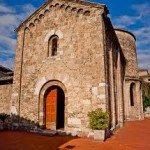 It is also called “ Tempio del Sole “ ( temple of the sun ) because it was built on what was considered a place of worship ( actually a bath ). It was started in the 8th century and trasformed in the 11th and 12th century. Inside and in the Cappella Manassei, paintings dating from 1300s to 1500s may be admired.
It is also called “ Tempio del Sole “ ( temple of the sun ) because it was built on what was considered a place of worship ( actually a bath ). It was started in the 8th century and trasformed in the 11th and 12th century. Inside and in the Cappella Manassei, paintings dating from 1300s to 1500s may be admired.
8 – San Pietro Church
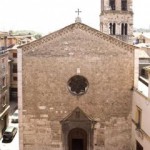 Built in the 14th century, it has undergone several alterations. The original Gothic layout is visible in the apse ( large three-light mullioned windows ). Inside, tourists can find interesting frescoes of the “ Dormitio Virgins “ by Maestro della Dormitio and the “ Stories of Saint Stephen “ ( 15th c. ).
Built in the 14th century, it has undergone several alterations. The original Gothic layout is visible in the apse ( large three-light mullioned windows ). Inside, tourists can find interesting frescoes of the “ Dormitio Virgins “ by Maestro della Dormitio and the “ Stories of Saint Stephen “ ( 15th c. ).
9 – Palazzo Spada
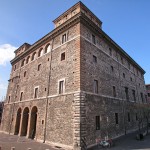 The present Town Hall, built in the 16th century, was probably designed by A. da Sangallo.
The present Town Hall, built in the 16th century, was probably designed by A. da Sangallo.
10 – Spear of Light Obelisk by Arnaldo Pomodoro
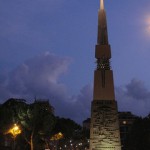 The masterpiece of Arnaldo Pomodoro is a monument which contains the meanings of many works put together. It is entirely made of special molten steel. Its particular shape of 30m in height emphasises the will to create a real “ monument “ that could pass on the history of a people to postery.
The masterpiece of Arnaldo Pomodoro is a monument which contains the meanings of many works put together. It is entirely made of special molten steel. Its particular shape of 30m in height emphasises the will to create a real “ monument “ that could pass on the history of a people to postery.
____________________________________________________
City of Terni: Surroundings
Stroncone
It has preserved the ambience of a mediaeval fortified village: the urban plan, the streets and the squares, the walls, the gateways, the palaces and, in general, the atmosphere of a bygone age. The Porta del Borgois its main gateway.
Tourist highlights:
San Nicolo’ Church with a splendid portal in low relief. Inside are 17th – 18th century paintings and a “ Coronation of the Virgin “ ( 1520-1521 ) by Rinaldo da Calvi;
San Giovanni Decollato Church: frescoes with “ Scenes from the Life of the Baptist “(G.Bastioni), a “ Baptism of Christ “ ( 1610 ).
San Michele Arcangelo Church: remarkable altarpiece of the “ Madonna of the Rosary “, (B.Barbiani, 1628 ) and the wooden Crucifix of 1300s.
The Town Hall, ancient mediaeval building hosting the Corali miniati, fine manuscripts which were probably created by the Maestro della Dormitio virgins, and the Bossolo dei priori, an old ballot box.
In San Francesco Convent, it is possible to admire a “ Madonna and Child with Saints “ by Tiberio d’Assisi with a picture of St Francis that seems to be the truest to his real features.
Collescipoli
The splendid Baroque style of the collegiate and the precious Hermans organ
A fortified village, strategically located to defend the Terni Valley and situated on a hill with two bell towers which jut out over the view.
Encircled by mediaeval walls along which are the Porta Ternana and Sabina. In the old part of the village stand prestigious churches and noble residences, such as Palazzo Ungari, Palazzo Cantucci, and Palazzo Genga.
San Nicolò Church and the Collegiate of Santa Maria are also worthy of note.
Cesi. Overlooking Terni Valley
Situated in a scenic location, it has preserved remarkable palaces and churches ( the former Sant’Angelo Church and former Sant’Andrea Church ). The parish contains one of the most important 14th century paintings, the Altarpiece by the Maestro di Cesi dating from 1308. Worth visiting are also the archaeological remains such as the Italic walls and the reusable materials gathered from Carsulae.
Miranda and the comet
It is a small mediaeval village, where every year the largest comet in the world is lit at Christmas.
In its surroundings stretch thick chestnut woods and the remains of San Benedetto in Fundis Abbey.
The Serra Valley – The parkland
Its Mediaeval hamlets and unspoilt nature entice tourists to a relaxing walk.
City of Terni
Hotel Michelangelo Palace Terni



